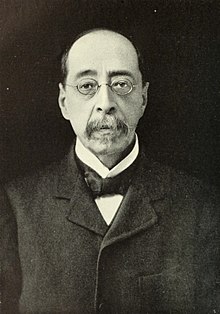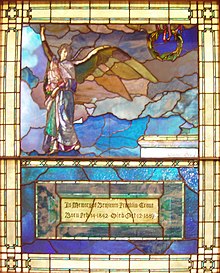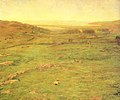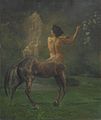John La Farge
John La Farge | |
|---|---|
 John LaFarge, 1902 | |
| Born | March 31, 1835 |
| Died | November 14, 1910(aged 75) |
| Nationality | American |
| Alma mater | Mount St. Mary's University Fordham University |
| Occupation(s) | Painter,stained glassartist,decorator,writer |
| Spouse |
Margaret Mason Perry
(m.1860) |
| Children | 8, includingChristopher,John |
| Signature | |
 | |
John La Farge(March 31, 1835 – November 14, 1910) was an American artist whose career spanned illustration, murals, interior design, painting, and popular books on his Asian travels and other art-related topics. La Farge made stained glass windows, mainly for churches on the American east coast, beginning with a large commission forHenry Hobson Richardson'sTrinity Churchin Boston in 1878, and continuing for thirty years. La Farge designed stained glass as an artist, as a specialist in color, and as a technical innovator, holding a patent granted in 1880 for superimposing panes of glass. That patent would be key in his dispute with contemporary and rivalLouis Comfort Tiffany.
La Farge rented space in theTenth Street Studio Buildingat its opening in 1858, and he became a longtime presence inGreenwich Village.In 1863 he was elected into theNational Academy of Design;in 1877 he co-founded theSociety of American Artistsin frustration at the National Academy's conservatism. In 1892 La Farge was brought on as an instructor with theMetropolitan Museum of Art Schoolsto provide vocational training to students in New York City.[1]He served as president of theNational Society of Mural Paintersfrom 1899 to 1904.[2]In 1904, he was one of the first seven artists chosen for membership in theAmerican Academy of Arts and Letters.
Early life[edit]
La Farge was born in New York City to wealthy French parents, Jean Frédéric "John Frederick" La Farge and Louise Joséphine "Louisa" La Farge (néeBinsse de Saint-Victor),[3][4]and was raised bilingually.[5]As a child, he and his brothers produced a handmade magazine in French entitledLe Chinois.[6]: 17
His interest in art began during his studies atMount St. Mary's Universityin Maryland[7]and St. John's College (nowFordham University) in New York. He studied law. His first visit to Paris in 1856[5]induced him to study painting withThomas Couture,and become acquainted with an artistic and literary social circle.[8]La Farge's earliest drawings and landscapes showed marked originality, especially in the handling of color values.
La Farge returned from Europe in October 1857, which ended his relationship with Couture. He returned to continue his law studies although, in his own words, at the same time "stealing as much time as I could for some of my new friends, the painters and architects."[9]These includedWilliam James Stillman,George Henry Boughton,and members of the second generation of theHudson River School.These circumstances changed with the death of his father in June 1858: the pressure to attend law school was gone, and there was a significant inheritance[9]which gave him the freedom to take studio space in the newly createdTenth Street Studio Buildingat 51 West 10th Street inGreenwich Village.The building's communal spaces for artists set the conditions for social networking; its central atrium and traditional Saturday receptions were important in the careers of its tenants, and to the artistic reputation of the Village. Its architectRichard Morris Huntrecommended that La Farge study under his brotherWilliam Morris HuntinNewport, Rhode Island.[10]The artist Hunt was also a product of Couture'satelier.
Career[edit]
Between 1859 and 1870, La Farge took up illustration, withTennyson'sEnoch ArdenandRobert Browning'sMen and Women,and worked on children's magazine illustrations with engraver Henry Marsh (American, 1826–1912).
In the 1870s, La Farge began to paint murals, which became popular for public buildings as well as churches. His first mural was painted inTrinity Church, Boston,in 1873. Then followed his decorations in theChurch of the Ascension(the large altarpiece) andSt. Paul's Chapel,New York. In his lunette muralAthensatBowdoin College Museum of Art,a building designed byCharles Follen McKim,the model for the central figure was the African-American museHettie Anderson.(Anderson also owned one of his paintings of Samoa.)[11]He also took private commission from wealthy patrons (e.g.Cornelius Vanderbilt) and was reputedly worth $150,000 at one point.[12]La Farge continued to create murals through his career: for theMinnesota State Capitolat St. Paul, at age 71, he executed four great lunettes representing the history of law. Also among his final works were six murals on the theme of eminent lawgivers, beginning with Moses, for the Baltimore City Court House, now theClarence M. Mitchell Jr. Courthouse.[13]
During an 1880s renovation of theSamuel J. Tilden Mansion,now home to theNational Arts Club,La Farge was one of several artisans hired by lead architectCalvert Vaux.He created stained glass panels for the interior of the mansion which remain today.[14]
La Farge traveled extensively in Asia and the South Pacific, which inspired his painting. He visited Japan in 1886 in the company ofHenry Adams,and theSouth Seasin 1890 and 1891, in particular spending time absorbing the culture of Samoa,Tahiti[5]and Fiji, again in Adams' company. In Hawaii in September 1890 he painted scenic spots onOahuand traveled tothe Island of Hawaiito paint an active volcano.[15]These travels are extensively recounted in his bookReminiscences of the South Seas,and in Adams' letters.
In 1863 he was elected into theNational Academy of Design;in 1877 he co-founded theSociety of American Artistsin frustration at the National Academy's conservatism (although he retained his National Academy membership). In 1892 La Farge was brought on as an instructor with theMetropolitan Museum of Art Schoolsto provide vocational training to students in New York City.[1]He served as president of theNational Society of Mural Paintersfrom 1899 to 1904.[2]In 1904, he was one of the first seven artists chosen for membership in theAmerican Academy of Arts and Letters.La Farge also received the Cross of theLegion of Honorfrom the French Government.
Stained glass[edit]
In 1875,[16]La Farge began experimenting with problems of shifting and deteriorating color, especially in the medium of stained glass. At this time, stained glass had not yet been widely adopted as a medium in the United States, making his early efforts critical to its success.[16]His work rivaled the beauty of medieval windows and added new resources by his use of opalescent glass and by his original methods of layering and welding the glass, which created a sense of three-dimensionality.[16]Opalescent glass had been used for centuries in tableware, but it had never before been formed into flat sheets for use in stained-glass windows and other decorative objects. For his early endeavors, La Farge had had to custom-order flat sheets of opalescent glass from a Brooklyn glass manufacturer.[17]
La Farge filed a patent application on Nov. 10, 1879, shortly after a newspaper account praised a recent window he made for Richard Derby of Long Island as "the first application of a new material [opalescent glass] to windows."[17]He was granted patent no. 224,831 on February 24, 1880, for a "Colored-Glass Window", with technical details about manufacturing opalescent sheet glass and layering it to create windows.[17]
Work[edit]
Among La Farge's many stained-glass works are windows at:
- Union Baptist Church of Baltimore(Baltimore) (1906)
- Trinity Church, Boston(1877–78)
- Biltmore EstateinAsheville, North Carolina(1881)
- Samuel J. Tilden House,NYC (1881; building converted into theNational Arts Clubin 1906)
- Thomas Crane Public Library,Quincy, Massachusetts(c. 1882)
- Unity Church ofNorth Easton, Massachusetts(1882)[18]
- Church of St. Joseph of ArimatheainGreenburgh, New York(1883)
- Blessed Sacrament Church,Providence, Rhode IslandThe church was designed byGeorge Lewis HeinsandChristopher Grant La Farge,LaFarge's brother-in-law, and his eldest son.https://library.bc.edu/lafargeglass/exhibits/show/descriptions/st-john/blessed-sacrament
- Christ Church inLincoln, Rhode Island(1884)
- Trinity Episcopal ChurchinBuffalo, New York(1886–89)
- St. Paul's Chapel,Columbia University,NYC (1888–99)
- All Saints Episcopal Church,Briarcliff Manor, New York(1889)
- All Souls Unitarian Church,Roxbury, Massachusetts
- First Unitarian Church of Detroit(1890)
- St. Mary's-in-Tuxedo Episcopal Church,Tuxedo Park, New York(1890)
- The Cathedral of All Saints, Albany, New York(c. 1890)
- Judson Memorial Church,NYC (1890–93)
- First Unitarian Church of Philadelphia(1891)
- Caldwell Sisters' chapel,Newport, Rhode Island,re-located to Our Lady of Mercy Chapel atSalve Regina Universityin Newport (1891)
- Mount Vernon Church, Boston(c. 1893)[19]
- Church of the Ascension, Episcopal, (Manhattan)
- Church of the Transfiguration, Episcopal,New York City (1898)
- John Harvard Window,Southwark Cathedral,London, England (1907)
Several of his windows, includingPeonies Blown in the Wind(1880), are in the collection of the Metropolitan Museum of Art, New York.
Dispute with Tiffany[edit]
La Farge apparently introduced Tiffany to the new use of opalescent glass sometime in the mid-1870s, showing him his experiments.[17]Sometime in the late 1870s or early 1880s, however, relations between the artists soured, probably due to a lawsuit between the two men.[6]: 34 [17]
Eight months later, Tiffany applied for a similar patent, which was granted in 1881 as no. 237,417. The major difference in their patents is that Tiffany lists somewhat different technical details, for instance relating to the air space between glass layers. Since La Farge's patent focused more on the material and Tiffany's more on its use in construction, it appeared that the two patents might be mutually dependent, prohibiting either artist from making stained-glass windows without the other's permission. There is some indication that La Farge may have come to some kind of agreement with Tiffany on the use of La Farge's patent, but the details are unclear and disputed by scholars.[17]What does seem certain is that around 1882 La Farge planned to sue Tiffany, claiming that Tiffany had infringed his patent by appropriating some of his working methods for opalescent sheet glass.[17]Official records of the lawsuit have not been found, suggesting it was never filed, but there are multiple references to it in the correspondence of both men.[17]Possibly, as stained glass increased in popularity, drawing other artists to the medium, both La Farge and Tiffany decided it would be too much trouble to legally defend their patents.
Personal life[edit]

On October 15, 1860, he was married to Margaret Mason Perry (1839–1925) at Newport, Rhode Island. She was the daughter of Christopher Grant Perry, and the granddaughter of CommodoreOliver Hazard Perry,and great-granddaughter ofSarah Franklin Bache.They were descendants of colonial leaders GovernorThomas Prence(1599–1673) and ElderWilliam Brewster(c. 1567–1644), who had been a passenger on theMayflower.[9]
Together, Margaret and John had eight children:
- Christopher Grant La Farge(1862–1938), who was a partner in the New York-based architectural firm ofHeins & LaFarge.He designed projects inBeaux-Arts style,notably the original ByzantineCathedral of St. John the Divine,the Yale undergraduate societySt. Anthony Hall(extant 1893–1913)[20]and the original Astor Court buildings of theBronx Zoo.
- Emily Marie La Farge (1862–1890), who married William Rehn Claxton
- John Louis Bancel La Farge(1865–1938), who married Mabel Hooper
- Margaret Angela La Farge (1867–1956)
- Oliver Hazard Perry La Farge (1869–1936), who also became an architect and real estate developer. Part of his career in real estate was in a Seattle partnership withMarshall Latham Bond,Bond & La Farge. He designed the Perry Building, still standing in the city. Later in life O.H.P. La Farge designed buildings forGeneral Motors.
- Joseph Raymond La Farge (1872–1872), who died in infancy
- Frances Aimee La Farge (1874–1951), who married Edward H. Childs (b. 1869)
- John La Farge, Jr., S.J.(1880–1963), who became aJesuitpriestand a strong supporter of anti-racist policies.[6]
La Farge died atButler Hospital,inProvidence, Rhode Island,in 1910.[21]The interment was atGreen-Wood Cemetery,inBrooklyn,New York.
Through his eldest son Christopher, he was the grandfather ofChristopher La Farge,a novelist and poet, andOliver La Farge,a noted writer andanthropologist.Peter La Farge,son of Oliver, was a celebrated songwriter in Greenwich Village in the 1960s. He penned "The Ballad of Ira Hayes," made famous by Johnny Cash.
Through his daughter Frances, he was the grandfather ofFrances Sergeant Childs,who was a member of the founding faculty ofBrooklyn College,where she was a professor of history.[22]
Writing[edit]
La Farge's writings include:
- The American Art of Glass(a pamphlet)
- Considerations on Painting(New York, 1895)
- An Artist's Letters from Japan(New York, 1897)
- The Great Masters(New York)
- Hokusai: a talk about Japanese painting(New York, 1897)
- The Higher Life in Art(New York, 1908)
- One Hundred Great Masterpieces
- Reminiscences of the South Seas(1912)
- The Gospel Story in Art(New York, 1913)
- Letters from the South Seas(unpublished)
- Correspondence(unpublished)
His papers, together with some of those of certain children and grandchildren, are held by Yale University Library.[23]
In popular culture[edit]
John La Farge is a minor character inAnya Seton's novelThe Hearth and Eagle,where he appears as a friend of the fictional artist Evan Redlake.
Notes and references[edit]
- ^abFinding aid for Schools of The Metropolitan Museum of Art Records (1879–1895).The Metropolitan Museum of Art. Retrieved July 31, 2014.
- ^ab"National Society of Mural Painters website".Archived fromthe originalon October 15, 2018.RetrievedFebruary 6,2020.
- ^Yarnall, James L. (1990).John La Farge, Watercolors and Drawings.Hudson River Museum. p. 16.ISBN9780943651248.RetrievedJune 8,2022.
- ^P. de La Barre de Nanteuil (January 2022)."Généalogie de la famille Binsse de Saint Victor".Calaméo(in French). pp. 24–25.RetrievedJune 8,2022.
- ^abcRoberts, Norma J., ed. (1988),The American Collections,Columbus Museum of Art,p.26,ISBN0-8109-1811-0.
- ^abcLaFarge, John, S.J.The Manner Is Ordinary.New York: Harcourt, Brace, 1954, pp. 28, 34.
- ^"Works by Mount Saint Mary's Alumnus to be Featured in Exhibit".emmitsburg.net.RetrievedJuly 6,2007.
- ^American Paintings and Sculpture at the Sterling and Francine Clark Art Institute,by Margaret C. Conrads, Sterling and Francine Clark Art Institute, Hudson Hills, 1990ISBN1-55595-050-7
- ^abcJames L. Yarnall; John La Farge (2012).John La Farge, a Biographical and Critical Study.Ashgate Publishing, Ltd. p. 50.ISBN978-1-4094-1172-7.
- ^His only painted full-length formal portrait was of Richard Howland Hunt, the young son of the architectRichard Morris Huntand nephew of the painter William Morris Hunt.[1]
- ^Kahn, Eve (September–October 2021). "The Woman Who Was Victory".The Magazine Antiques:68–75.
- ^"Art, Music and the Drama".The Week: A Canadian Journal of Politics, Literature, Science and Arts.2(1): 26. December 13, 1883.RetrievedApril 20,2013.
- ^Yarnall, James L. (June 5, 2017).John La Farge, A Biographical and Critical Study.Taylor & Francis. p. 237.ISBN9781351561556.RetrievedMay 4,2021.
- ^"The Clubhouse - The National Arts Club".nationalartsclub.org.RetrievedJanuary 13,2022.
- ^Forbes, David W.,Encounters with Paradise: Views of Hawaii and its People, 1778–1941,Honolulu Academy of Arts, 1992, 201–220.
- ^abcDupré, Judith (2010).Full of Grace: Encountering Mary in Faith, Art, and Life(1st ed.). New York: Random House. p. 42.ISBN978-1-4000-6585-1.OCLC482623356.
- ^abcdefghSloan, Julie L."The Rivalry Between Louis Comfort Tiffany and John La Farge".
- ^Neely, Robin (Spring 2007)."Two Masterpieces: La Farge Windows in North Easton, Massachusetts"(PDF).Stained Glass.102(1): 40–64. Archived fromthe original(PDF)on July 1, 2017.RetrievedFebruary 19,2016.
- ^Julie L. Sloan and James L. Yarnall. "Art of an Opaline Mind: The Stained Glass of John La Farge,"American Art Journal,Vol. 24, No. 1/2 (1992)
- ^Yale's Lost Landmarks.ArchivedFebruary 27, 2007, at theWayback Machine
- ^American Art Annual, Volume 9.MacMillan Company. 1911. p. 314.
- ^"Childs-LaFarge".Newport Mercury,June 16, 1900.
- ^"Guide to the La Farge Family Papers MS 24".Yale University Library website.
Bibliography[edit]
- Adams, Foster, La Farge, Weinberg, Wren and Yarnell,John La Farge,Abbeville Publishing Group,NY, NY 1987
- Cortissoz, Royal,John La Farge: A Memoir and a Study,Houghton Mifflin Company,Boston 1911
- Forbes, David W., "Encounters with Paradise: Views of Hawaii and its People, 1778–1941", Honolulu Academy of Arts, 1992, 201–220.
- Gaede, Robert and Robert Kalin,Guide to Cleveland Architecture,Cleveland Chapter of the American Institute of Architects, Cleveland OH 1991
- Kowski, Goldman et al.,Buffalo Architecture:A Guide,The MIT Press,Cambridge MA 1981
- Mather, Frank Jewett Jr.(April 1911)."John La Farge – An Appreciation".The World's Work: A History of Our Time.XXI:14085–14100.RetrievedJuly 10,2009.
- Waern, Cecilia,John La Farge: Artist and Writer,Seeley and Co. Limited, London 1896
Gallery[edit]
-
Portrait of William James, circa 1859
-
Agathon to Erosanthe, Votive Wreath,1861
-
Portrait of the NovelistHenry James,1862
-
Wreath of Flowers,1866,Smithsonian American Art Museum
-
Paradise Valley,1866–68
-
The Golden Age,1878,Smithsonian American Art Museum
-
Portrait of Faase, the Taupo of the Fagaloa Bay, Samoa,1881
-
The Great Statue of Amida Buddha at Kamakura,1886
-
Centauress,c. 1887
-
Kilauea, Looking at Cone of Crater,1890,Honolulu Museum of Art
-
Girls Carrying a Canoe, Vaiala in Samoa,1891
-
Study of Afterglow from Nature (Tahiti: Entrance toTautiraValley),1891,Princeton University Art Museum
-
Young Girls Preparing Kava Outside of the Hut whose Posts are Decorated with Flowers,1891
-
View in Ceylon, near Dambula
-
Diadem Mountain at Sunset, Tahiti-Brooklyn Museum
-
Title illustration for theCollier's Weeklyserialization ofThe Turn of the Screw,1898
External links[edit]
- STAINED GLASS QUARTERLY OF THE STAINED GLASS ASSOCIATION OF AMERICA Volume 102, Number 1 • Spring 2007,"Two American Masterpieces restoried"
- "John La Farge's South Seas Sketchbooks:1890–1891" at the Yale University Art Gallery
- La Farge Gallery at MuseumSyndicateArchivedOctober 28, 2014, at theWayback Machine
- John La Farge exhibition catalogs
- Works by John La FargeatProject Gutenberg
- Works by or about John La FargeatInternet Archive
- John La Farge Stained Glass in New England: A Digital Guide (Boston College Libraries)
- John La Farge drawings, circa 1860-1899.Held by the Department of Drawings & Archives,Avery Architectural & Fine Arts Library, Columbia University.
![]() This article incorporates text from a publication now in thepublic domain:Herbermann, Charles, ed. (1913). "John LaFarge".Catholic Encyclopedia.New York: Robert Appleton Company.
This article incorporates text from a publication now in thepublic domain:Herbermann, Charles, ed. (1913). "John LaFarge".Catholic Encyclopedia.New York: Robert Appleton Company.
- 1835 births
- 1910 deaths
- American muralists
- American Roman Catholics
- Knights of the Legion of Honour
- Art Students League of New York faculty
- Fordham University alumni
- American stained glass artists and manufacturers
- Burials at Green-Wood Cemetery
- American people of French descent
- Painters from New York City
- Hawaii artists
- 19th-century American painters
- 19th-century male artists
- American male painters
- 20th-century American painters
- Members of the American Academy of Arts and Letters
- Perry family
- La Farge family
- Fordham Preparatory School alumni






















